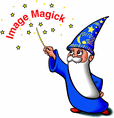

ImageMagick has a number of functions that allow you to read, manipulate, write, or display an image. These functions are accessible through the various tools or the object-oriented Perl interface, PerlMagick. However, you can also access the functions directly from your program through the Magick Application Programmer Interface. To invoke the functions, write your program in your favorite language while making calls to the Magick image functions and link with libMagick.a, libMagick.so, or Magick.dll depending on your system.
The API is divided into a number of categories:
Here is a sample program to get you started. To find out about all the functions that are available, read the source code. Each function is delineated with a full rows of percent signs with comments describing the parameters required for the function and what it does. For ease in finding a function, they are sorted in alphabetical order. Most of the image functions are found in image.c and effects.c.
Here is a full example of a program, demo.c, that reads a JPEG image, creates a thumbnail, and writes it to disk in the PNG image format.
#include <stdio.h>
#include <string.h>
#include <time.h>
#include <sys/types.h>
#include <magick/api.h>
int main(int argc,char **argv)
{
ExceptionInfo
exception;
Image
*image,
*images,
*resize_image,
*thumbnails;
ImageInfo
*image_info;
/*
Initialize the image info structure and read an image.
*/
InitializeMagick(*argv);
GetExceptionInfo(&exception);
image_info=CloneImageInfo((ImageInfo *) NULL);
(void) strcpy(image_info->filename,"image.gif");
images=ReadImage(image_info,&exception);
if (exception.severity != UndefinedException)
CatchException(&exception);
if (images == (Image *) NULL)
exit(1);
/*
Turn the images into a thumbnail sequence.
*/
thumbnails=NewImageList();
while ((image=ShiftImageList(&images)) != (Image *) NULL)
{
resize_image=ResizeImage(image,106,80,MitchellFilter,1.0,&exception);
if (resize_image == (Image *) NULL)
MagickError(exception.severity,exception.reason,exception.description);
(void) PushImageList(&thumbnails,resize_image,&exception);
DestroyImage(image);
DestroyImage(resize_image);
}
/*
Write the image as MIFF and destroy it.
*/
(void) strcpy(thumbnails->filename,"image.miff");
WriteImage(image_info,thumbnails);
DestroyImageList(thumbnails);
DestroyImageInfo(image_info);
DestroyExceptionInfo(&exception);
DestroyMagick();
return(0);
}
Now we need to compile. On Unix, the command would look something like
this:
setenv LD_LIBRARY_PATH /usr/local/lib gcc `Magick-config --cflags --cppflags` demo.c `Magick-config --ldflags --libs`Another example is smile.c. Compile and excute it to display a smiley face on your X server.
For C++, use:
g++ `Magick++-config --cxxflags --cppflags` demo.cpp `Magick++-config --ldflags --libs`